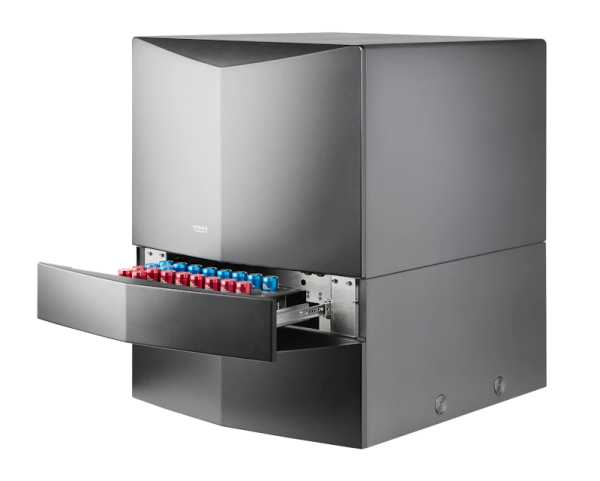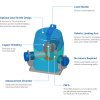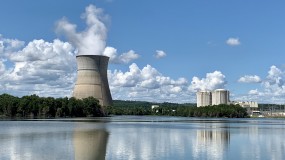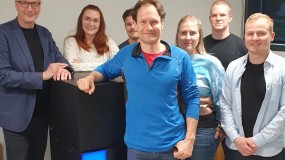The most advanced, compact counter available
The Hidex 300 SL is a compact liquid scintillation counter with exceptionally high counting efficiency. It is the most advanced counter available featuring luminescence free counting and three PMT detectors for Triple-to-Double Coincidence Ratio (TDCR), a method for absolute activity counting without using an external source for calibration.
Being smaller and lighter than other counters, the Hidex 300 SL is ideal for mobile labs and smaller research spaces. Because it is front-loading, it can be conveniently installed underneath benches or in tighter spaces.
In addition to the standard counter, the Hidex 300 SL is available in other models for specific applications.
Hidex 300 SL Academic
Designed for academia and research, the Hidex 300 SL Academic is an affordable counter for applications using beta-emitting isotopes. It is ideal for cell studies, cytotoxicity measurements and contamination control in universities and research institutes.
| Specifications | |
| Sample capacity, 20mL/7mL | 40/96 |
| Counting efficiency ³H/¹⁴C (%) | 65/96 |
| Background ³H in water 8 + 12 (CPM) | 15 |
| Dimensions (W/H/D) | 52 x 68 x 63 cm |
| Weight | 115 kg (253 lbs) |
Hidex 300 SL Metrology
Designed for isotope metrology applications, the Hidex 300 SL Metrology includes TDCR data required for metrology calculation models.
| Specifications | |
| Sample capacity, 20mL/7mL | 40/96 |
| Counting efficiency ³H/¹⁴C (%) | 65/96 |
| Background ³H in water 8 + 12 (CPM) | 12 |
| Dimensions (W/H/D) | 52 x 68 x 63 cm |
| Weight | 125 kg (275 lbs) |
Hidex 300 SL Super Low Level
The Hidex 300 SL Super Low Level is designed for measuring 3H in water, environmental monitoring, radiocarbon dating and biofuel applications. It has additional lead shielding, a digital lead shield, low-level PMT detectors and an active guard detector to further reduce background.
The active guard is a separate scintillator detector which detects and subtracts background radiation. It can be turned off for high-energy samples and does not interfere with alpha/beta separation.
| Specifications | |
| Sample capacity, 20mL/7mL | 40/96 |
| Counting efficiency ³H/¹⁴C (%) | 70/96 |
| Background ³H in water 8 + 12 (CPM) | 4 |
| Dimensions (W/H/D) | 52 x 68 x 63 cm |
| Weight | 180 kg (397 lbs) |
Features
TDCR
The Hidex 300 SL uses three PMTs compared to the two other counters use. This allows Triple-to-Double Coincidence Ratio (TDCR), which is an absolute counting method for obtaining counting efficiency of the samples without an external or internal standard source. Unlike external standard methods, TDCR is a universal method applicable for chemical and color quenching, for aqueous and organic samples, and for different cocktails and isotopes.
Quench correction using an external standard source is available as an optional feature for users who prefer to continue measurements adhering to ISO methods.
Three PMTs
The Hidex 300 SL uses three PMTs aligned at 120° from each other. This optimal detection geometry yields in better detection geometry than conventional double coincidence detectors. And the more quenching, the greater the advantage of triple coincidence detectors.
Temperature Control
An optional temperature control module maintains sample integrity when conducting long count times, with 15-20 °C being the optimal range. Temperature control is not necessary for luminescence mitigation.
Luminescence Free Counting
The Hidex 300 SL can be used in triple coincidence mode which removes interference from chemiluminescence and reduces the effect of other low-energy noise events. Samples with long luminescence decay such as 14C in NaOH can be counted immediately without the need to dark adapt.
Alpha/Beta Separation
Alpha/beta separation is an optional feature of the Hidex 300 SL. It provides extremely sensitive detection of alpha-emitting isotopes in the presence of high beta radiation. Calibration and results validation can be done using spectrum analysis. Separation even works for unknown mixtures of alpha and beta isotopes.
This reduces the possibility of measurement errors typical for conventional misclassification methods, where calibration is often done using different conditions and isotopes than those found in unknown samples. Typical applications include the detection of 222Rn, 226Ra, 228Ra, 241Am and gross alpha/beta.
Optional External Standard Source
An optional external 152Eu standard source may be included for additional quench correction for users who prefer to continue measurements adhering to ISO 17025 accredited methods.
Software
The Hidex 300 SL is controlled by Hidex’s MikroWin software running on an external computer. Other counters typically feature an internal computer physically built-in to the counter itself. If these integrated computers fail, it renders the whole instrument inoperable, whereas the Hidex 300 SL’s operations are unaffected with software running on any computer. This also allows regular software and operating system updates, meaning users always have access to the latest versions.
Applications
Nuclear Energy
Fission and fusion measurements
Liquid scintillation counting is routinely used in nuclear power for both fission and fusion measurements. The Hidex 300 SL’s unique three detector PMT detectors can aide in luminescence free counting and radioisotope qualification via TDCR.
| Isotope | Application | Code |
| 3H | 3H in drinking water with TDCR radioisotope qualification | ASTM D4107 |
| 55F | 55F in wastewater with TDCR radioisotope qualification | ASTM D4299 |
| 14C | 14C in effluents with luminescence free counting | ASTM D7938 |
Oil & Gas
Measuring naturally-occurring 14C
Liquid scintillation counting is being increasingly used in the oil and gas industries for naturally occurring 14C measurements. The biocontent of renewable fuels such as biodiesel, biogasoline, and sustainable aviation fuels (SAFs) can be measured directly with no sample preparation. More difficult samples such as marine fuel and biobitumen can be synthesised into benzene and then measured via LSC.
| Isotope | Application | Code |
| 14C | Benzene synthesis method | ASTM D6866 |
| 14C | Direct method with no sample preparation | ASTM D6866 |
Environmental & NORM
Counting naturally occurring radioactive materials
Liquid scintillation counting is being for environmental and Naturally Occurring Radioactive Materials (NORM) monitoring. The Hidex 300 SL’s unique 2D/3D alpha/beta separation leads to zero misclassifications between alpha and beta emitters regardless of isotope keV and isotope mixture.
| Isotope | Application | Code |
| Gross α/β | Gross alpha/beta with no misclassification | ASTM D4107 |
Hidex 300 SL existing users
Click the tabs below to learn more about our customers and their applications for the Hidex 300 SL.
Nuclear
SURO, Czech Republic
"... we are very happy with its operation, and its maintenance has been very simple.”
With a focus on protection against ionising radiation, SURO is a part of the Czech Republic’s national system for radiation monitoring. As such, Head of Radiochemistry Dr. Michal Fejgl and his department analyze environmental and food chain samples, as well as independently monitoring two nuclear power plants at Temelín and Dukovany. The team would also be responsible for emergency monitoring in the event of an accident.
Dr. Fejgl said, "We have used the Hidex 300 SL for six years. Its digital lead shield was a new feature at the time, and it was able to meet our original specification of counting tritium at 1.2 Bq/litre. Other models of LSC were both prohibitively expensive in the Czech Republic and employed active shielding, which we found produced misleading results meaning they were unreliable for statistical analysis.
“Considering how many years we have been using the 300 SL and its original cost, I can say we are very happy with its operation, and its maintenance has been very simple.”
You can find out more about SURO and Dr. Fejgl's work by clicking the button below.
Radsol, South Korea
Radiochemical analysis of environmental and nuclear decommissioning samples

Radsol CEO Dr. Jung-Suk Oh's laboratory houses three Hidex 300 SL liquid scintillation counters.
The Hidex 300 SL is being used by Radsol for the radiochemical analysis of environmental and nuclear decommissioning samples in South Korea. The country is the world’s fifth biggest generator of nuclear energy with a total of 26 reactors providing 26 GWe of electricity, approximately a third of all electricity produced. Two reactors – Kori 1 and Wolsong 1 – have been shut down and are currently in the process of being decommissioned.
Radsol specialises in the measurement and analysis of radioisotopes, providing the Korean Research Institute of Standards and Science (KRISS) with a range of radioanalytical services including measuring 3H in seawater, bioassays for radiation workers, and nuclear waste characterisation. The company has three 300 SLs to achieve a high throughput of work.
You can learn more by clicking the button below.
Watts Bar Nuclear Power Plant, USA
Advanced tritium analysis at nuclear power stations
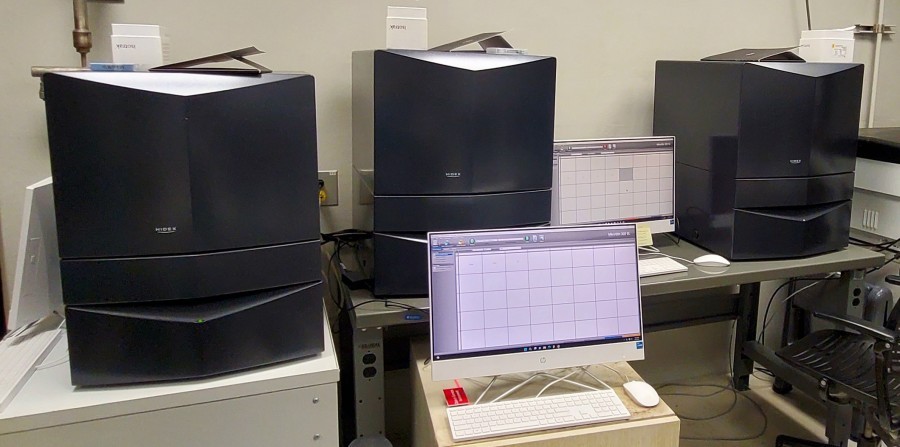
Watts Bar’s three Hidex 300 SLs in their Chemistry Department.
Three Hidex 300 SL liquid scintillation counters have been installed at the Tennessee Valley Authority’s Watts Bar nuclear power plant where it is used by the Chemistry Department to count tritium in various plant samples, including gaseous and liquid effluents. The NPP generates enough electricity for 1,200,000 homes.
We spoke to Radiological Chemist Brooke Underwood. Click the button below to find out what she had to say.
Babcock Marine, UK
The decommissioning of Royal Navy nuclear submarines
Radiochemists at Babcock Marine's Rosyth Radiochemistry Laboratory (RCL) have been using the Hidex 300 SL to determine tritium and carbon-14 in samples as part of the Ministry of Defence’s Submarine Dismantling Project. The RCL is responsible for analyzing environmental samples from both the Rosyth Dockyard itself and the decommissioned submarines berthed there.
Click the button below to find out what Radiochemist Lionel Serafini thinks of the 300 SL.
Environmental
Idaho State University, USA
Can you remove vacuum distillation from tritium sample preparation?
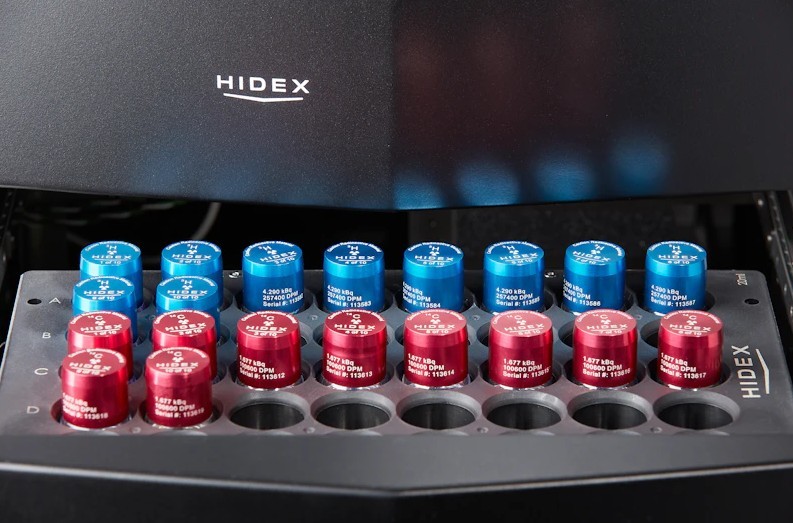
Vacuum distillation is a critical step in the preparation of tritium samples for liquid scintillation counting. It is used to purify and isolate enriched tritium water of potential contaminants such as sodium hydroxide (NaOH) to produce a clean, distilled sample before analysis.
NaOH, used during electrolytic tritium enrichment, can interfere with scintillation counting by increasing chemiluminescence and quenching, both of which reduce measurement accuracy. Vacuum distillation ensures that only clean water with enriched tritium reaches the LSC, enabling precise and reliable measurements.
In a study by MS Student Blaine Gustafson at Idaho State University, the Hidex 300 SL was used to determine if the process of vacuum distillation could be removed from the tritium sample preparation process without compromising measurement accuracy. The study evaluated the 300 SL’s Triple to Double Coincidence Ratio (TDCR) to determine if it provided more reliable results in the presence of chemiluminescence than a traditional LS counter.
Click the button below to find out the results of Blaine's study and the 300 SL's improved chemiluminescence handling.
Montana Bureau of Mines and Geology, USA
Counting radon in water

As a mountainous state with large granite batholiths, Montana has relatively high levels of radon. As the radon dissolves into groundwater, it can contaminate wells in rural areas where mains water may not be accessible. While radon in water – 222Rn-H2O – is generally less concerning than radon gas indoors, it can still contribute to overall exposure when it is released into the air during washing and cooking.
The Montana Bureau of Mines and Geology (MBMG) serves as the state’s geological survey. Based at Montana Tech, hydrogeologists have been using a Hidex 300 SL for many years to analyze collected water samples.
Click the button below to find out how the 300 SL's automated functionality helps labs manage unequilibrated samples.
University of Surrey, UK
Quantifying radiolabelled CECs
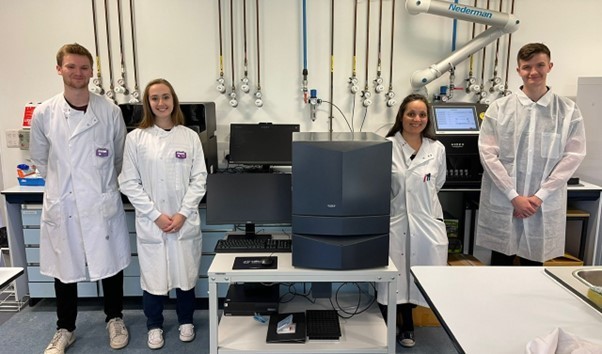
The ARIEL team at the University of Surrey with Dr. Al Sid Cheikh (second from right) with Product Specialist Luke Brammer (far right).
Hidex instruments are being used by the University of Surrey’s Applied-RadioIsotope and Environmental Laboratory (ARIEL) to research and understand the fate and behaviour of contaminants of emerging concerns (CECs). CECs are pollutants such as domestic chemicals, pharmaceuticals, and agricultural runoff detected in bodies of water.
Lead by Dr. Maya Al Sid Cheikh, the research is specifically concerned with nanoplastics, which are ubiquitous in domestic products and discharged in large quantities from industrial processes and can have devastating impacts on biodiversity, ecosystems, and food chains. Maya and her team at ARIEL are trying to trace these from origin through to dispersion in the environment and living organizms to understand how long they persist by 14C radiolabeling.
You can find out more about ARIEL's research by clicking the button below.
Colorado School of Mines, USA
Radiometric analysis of heavier actinides

The Colorado School of Mines is a public R1 research university focused on applied science and engineering. The Mines Radiochemistry Lab uses radioactive elements to solve complex problems in nuclear energy, the separation and purification of metals, the disposal of nuclear waste, and the environment.
The school’s lab is also one of only two university labs in the world that experiments with rare and highly radioactive heavy actinide elements such as Berkelium, Einsteinium, and Fermium. Research Assistant Professor Jessica Jackson has been using the Hidex 300 SL for a range of radiometric analysis experiments using alpha-beta discrimination. The LSC’s unique topographical 3D separation was a key reason why the school procured the Hidex over another model.
Click the button below to find out more.
Documents
-
Hidex-300-SL-and-600-SL-Brochure-US-Version-1.4
Download (3.85 MB)
Catalogues
-
Monitoring-and-Analytical-Equipment-EU-Version-1.3
Download (28.21 MB)

